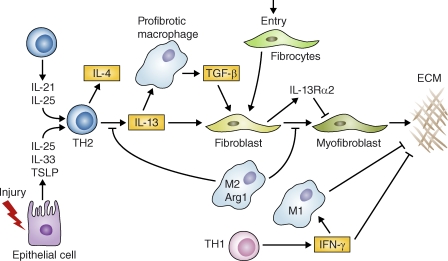Figure 3.
Specialized subsets of T helper cells and macrophages play distinct roles in pulmonary fibrosis. After injury, epithelial cells release IL-25, IL-33, and TSLP, which can facilitate the development of profibrotic Th2 responses. T cells also release IL-21 and IL-25, which promote Th2 differentiation. Th2 cells release IL-4 and IL-13, which promote the development of a profibrotic macrophage subpopulation that secretes TGF-β1 among other mediators. IL-13 can also directly activate fibroblasts independently of TGF-β1. Th2 cytokines also trigger specific chemokines that promote the recruitment of collagen-secreting fibrocytes from the bone marrow, which amplify fibrotic responses. The resulting myofibroblasts release ECM components. However, Th2 cytokines can also trigger antifibrotic feedback mechanisms. For example, Th2 cytokines activate arginase-1 activity in M2 macrophages, which inhibit further IL-13 production and myofibroblast differentiation. IL-13 can also up-regulate the IL-13 decoy receptor in fibroblasts, which antagonizes ECM production via a negative feedback loop. In addition, IFN-γ, produced by Th1 cells, exhibits potent antifibrotic activity by suppressing collagen synthesis in fibroblasts and by promoting the activation of inflammatory M1 macrophages that favor ECM degradation. Interactive PPT slides for this figure are available online.

